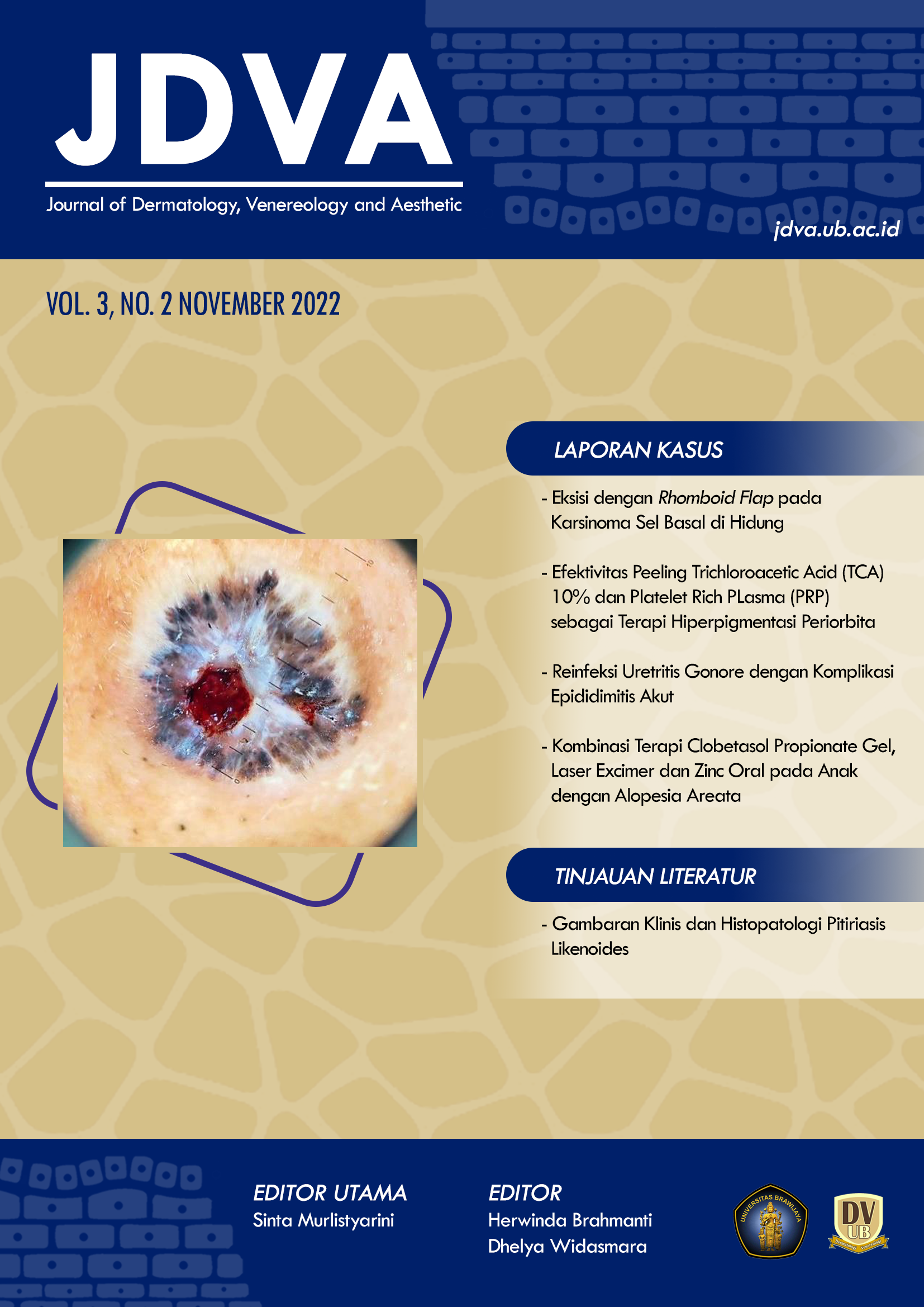PLATELET-RICH PLASMA VERSUS PLATELET-RICH FIBRIN INJECTION IN TREATMENT OF ACNE SCARS
Abstract
Acne scars are a consequence of abnormal wound healing after damage to sebaseous follicles during acne inflammation. Acne scars can be classified into icepick, boxcar, and rolling atrophy in addition to keloid scars and hypertrophy. The 21-year-old man complained of acne scars on the cheeks, temples, forehead and jaw since 3 years ago. Concave-shaped acne scars appear on the location of acne. Scars still appear even from a distance of more than 50 cm. Dermatological examination of the forehead, temples, cheeks and chin was obtained: atrophic scars, linear scars and papular hyperplastic scars. Atrophic scars were lost on stretching. Assessment was conducted with Goodman's global scarring grading system, quantitative scores on the right side of the face 19 points and the left side 20 points, and qualitative grade 3 scores. Patient was diagnosed with moderate degree scar, then injected PRP on the right face and PRF injection on the left face. Therapy was given 2 times at intervals of 3 weeks. Evaluation at week 5 found a decrease in quantitative scores to 15 points on the right face and 16 points on the left face. High concentrations of growth factors and cytokines contained in PRP can modulate cell proliferation, differentiation, angiogenesis, and chemotaxis. Platelet-rich fibrin secretes material that resembles when the wound occurs, with better results on the face that was injected with PRF because in PRF there is a minimal cellular inflammatory reaction and significant activation of fibroblasts and collagen production.
Keywords
Full Text:
PDFReferences
Gadkari R, Nayak C. A split‐face comparative study to evaluate efficacy of combined subcision and dermaroller against combined subcision and cryoroller in treatment of acne scars. Journal of cosmetic dermatology. 2014 Mar;13(1):38-43.
Hession MT, Graber EM. Atrophic acne scarring: a review of treatment options. The Journal of clinical and aesthetic dermatology. 2015 Jan;8(1):50.
Zaleski-Larsen LA, Fabi SG, McGraw T, Taylor M. Acne scar treatment: a multimodality approach tailored to scar type. Dermatologic Surgery. 2016 May 1;42:S139-49.
Gawdat HI, Hegazy RA, Fawzy MM, Fathy M. Autologous platelet rich plasma: topical versus intradermal after fractional ablative carbon dioxide laser treatment of atrophic acne scars. Dermatologic Surgery. 2014 Feb;40(2):152-61.
Gamil HD, Ibrahim SA, Ebrahim HM, Albalat W. Platelet-Rich Plasma Versus Tretinoin in Treatment of Striae Distensae: A Comparative Study. Dermatologic Surgery. 2018 May 1;44(5):697-704.
Fiatiningsih, I., Wirohadidjojo, W. Pengobatan ulkus kronis penyakit jaringan ikat dengan fibrin kaya platelet. MDVI 2014; 41/3:124-128
Murlistyarini S, Akne Vulgaris. Malang: UB Press. 2019.
Levy LL, Zeichner JA. Management of acne scarring, part II. American journal of clinical dermatology. 2012 Oct 1;13(5):331-40.
Beylot C, Auffret N, Poli F, Claudel JP, Leccia MT, Del Giudice P, Dreno B. Propionibacterium acnes: an update on its role in the pathogenesis of acne. Journal of the European Academy of Dermatology and Venereology. 2014 Mar;28(3):271-8.
Nofal E, Helmy A, Nofal A, Alakad R and Nasr M. Platelet-rich plasma versus CROSS technique with 100% trichloroacetic acid versus combined skin needling and platelet rich plasma in the treatment of atrophic acne scars: a comparative study. Dermatologic Surgery. 2014 August;40(8):864-873.
Elman M, Frank I, Cohen-Froman H, Harth Y. Effective treatment of atrophic and icepick acne scars using deep non-ablative radiofrequency and multisource fractional RF skin resurfacing. JCDSA. 2012;2(04):267-272.
Ibrahim ZA, El‐Tatawy RA, El‐Samongy MA, Ali DA. Comparison between the efficacy and safety of platelet‐rich plasma vs. microdermabrasion in the treatment of striae distensae: clinical and histopathological study. Journal of cosmetic dermatology. 2015 Dec;14(4):336-46.
Leo MS, Kumar AS, Kirit R, Konathan R, Sivamani RK. Systematic review of the use of platelet‐rich plasma in aesthetic dermatology. Journal of cosmetic dermatology. 2015 Dec;14(4):315-23.
Na Ji, Choi Jw, Choi Hr, Jeong Jb, Park Kc, Youn Sw, Huh Ch. Rapid healing and reduced erythema after ablative fractional carbon dioxide laser resurfacing combined with the application of autologous platelet‐rich plasma. Dermatologic Surgery. 2011 Apr;37(4):463-8.
Ibrahim MK, Ibrahim SM, Salem AM. Skin microneedling plus Platelet-Rich Plasma versus skin microneedling alone in the treatment of atrophic post acne scars: a split face comparative study. J Dermatolog Treat 2017:1-6.
Satriyo A, Djukardi EK, Zubier F. Peran Plasma Kaya Trombosit (Platelet-Rich Plasma) Di Bidang Dermatologi. MDVI. 2011. 38 (1): 22-28
Hidajat D, Malik DA, Buditjahjono S. Platelet-Rich Plasma Dalam Dermatologi. MDVI. 2012. 39 (4): 176-85
Sclafani AP, Saman M. Platelet-rich fibrin matrix for facial plastic surgery. Facial Plastic Surgery Clinics. 2012 May 1;20(2):177-86.
Eshghpour M, Majidi MR, Nejat AH. Platelet-rich fibrin: An autologous fibrin matrix in surgical procedures: A case report and review of literature. Iranian journal of otorhinolaryngology. 2012;24(69):197.
Sclafani AP. Safety, efficacy, and utility of platelet-rich fibrin matrix in facial plastic surgery. Archives of facial plastic surgery. 2011 Jul 18;13(4):247-51.
Sclafani AP, McCormick SA. Induction of dermal collagenesis, angiogenesis, and adipogenesis in human skin by injection of platelet-rich fibrin matrix. Archives of facial plastic surgery. 2012 Mar 1;14(2):132-6.
Refbacks
- There are currently no refbacks.

This work is licensed under a Creative Commons Attribution-ShareAlike 4.0 International License.

